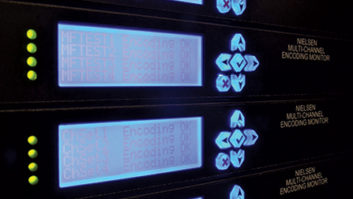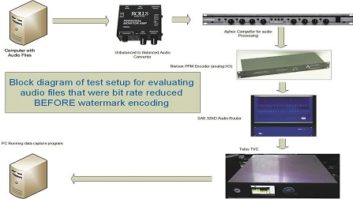Broadcast engineers in the top 50 radio markets will have new responsibilities when Arbitron switches each market from ratings based on paper-and-pencil diaries to ratings collected electronically by the Portable People Meter system.
Because we know all too well that the last thing most station engineers want or need is something else to worry about, we’ve developed technology and put systems in place to make this new task as seamless and transparent as possible.
With diaries, Arbitron bears the sole responsibility for gaining the cooperation of audiences to record their radio listening. The PPM represents a fundamental change in how ratings are generated and requires a more collaborative approach.
Stations are being asked to encode their broadcasts with inaudible codes, using encoders and monitors provided by Arbitron. These encoders use a proven psychoacoustic masking technology to inaudibly embed a unique “serial number” into the station’s audio.
We begin our collaborative efforts with stations by establishing a comfort level with the GM, who tells the station engineer, “We want to encode.” Arbitron’s Encoding Operations group then works with station engineers to obtain the specifics for each encoder we will be programming for the station.
Encoding Operations group
On the front lines of Arbitron’s Encoding Operations is a group of broadcast industry engineers. These Arbitron employees are SBE members and are focused on working with station engineers to ensure a smooth installation of Arbitron’s encoding equipment.
A single engineer is the primary point of contact for all stations in a given market for both the initial installation as well as any followup work or assistance. This way, a station engineer can count on contacting an engineer at Arbitron who is familiar with that station and its specific needs.
Station engineers are our source for the details and diagrams on the signal routing throughout their facility. We use this information to decide mutually where the encoder should be installed to ensure it would function properly.
Each encoder goes through a configuration process to make sure all the parameters are consistent with the particular station’s needs. This is followed by a checkout process, where we ensure the encoder is working properly, and a burn-in process, where we install the code.
We then run the encoder for at least 48 hours. Finally, we check it for encoding and conduct a listening test to ensure top audio quality and encoding performance.
Each encoder shipped to a station is marked clearly and identified for its respective audio stream. Detailed installation instructions are provided, and we have an Arbitron engineer ready to answer questions or go on-site for installation.
A separate encoder is provided for each feed: terrestrial analog, HD main and subchannels and Internet. Supported formats include analog mono, analog stereo, and AES/EBU digital at sample rates of 32, 44.1 and 48 kHz.
There is no cost to stations to encode and stations are not required to subscribe to the PPM ratings. Even non-subscribing stations can receive two encoders and a monitor free of charge.
Encoding backup systems
PPM also requires encoding the station’s own backup systems. If the station has two parallel, independent signal paths through the facility going out to the same transmitter or to two different transmitters, we want encoders in place with the backup system as well.
Even with smaller stations that have one signal path through the facility, we still stipulate primary and backup encoders and recommend that they be set up in series, with one in “bypass” mode. That way, in the unusual event that encoding problems surface on one, the station engineer quickly can move the suspect encoder out of the program audio path by switching it to the bypass mode, and get the backup encoder into service by switching it to “encode” mode.
Once the equipment is installed, the station’s engineer and Arbitron Encoding
Operations test each encoder (main and backup) to make sure the equipment is functioning properly. This requires a return-air audio sample from each encoder.
The audio sample can be checked on-site by an Arbitron engineer, recorded and e-mailed, or even checked over the phone, because the code is embedded within the audio. In the latter case, it’s a simple matter of having the engineer call us and hold the phone to a monitor speaker.
Once all components have been tested and we have confirmed that the station’s broadcasts are encoded properly, we will begin reporting audience estimates for that station.
Encoding is at the core of our Portable People Meter service. The PPM tracks panelists’ exposure to broadcasts by detecting the codes embedded in the audio delivered by broadcasters. This means that it is vitally important to be sure that every minute of airtime for every distribution channel leaving the station includes these codes. Otherwise, the PPM will be unable to credit exposure to the station.
Interrupted encoding
In order for stations to be able to monitor the status of their encoding, Arbitron provides an encoding monitor. Since it is impossible to hear the encoding, these monitors are an important tool to allow the station to ensure 100 percent encoding coverage.
The PPM monitor detects codes in the broadcast signal and will sound an alarm or send out an alert if the station’s code is missing. Most stations interface the monitor with their air-fault alarm system, but the monitor can be used in a variety of ways to suit the station’s needs.
Interface options include dry contact relay outputs as well as a serial port for computer interface. A detailed user’s manual is provided that outlines connection and use for all available options.
The key is to use this tool in such a way as to alert station personnel immediately should the encoding be interrupted. Historically, these interruptions typically have not been a function of encoding failure, but of innocent changes by the station as a function of maintenance or troubleshooting.
For example, if a station patches around a group of equipment that includes the encoder in order to replace a piece of equipment, there may be no audible change in the station’s air. If this patch is not pulled once maintenance is complete, there will be no encoding.
However, the encoding monitor will alarm. If the alarm is installed so that it alerts station personnel, the situation can be remedied immediately and encoding can continue uninterrupted.
Continuing communication also is key to uninterrupted encoding. Stations need to let us know if they make changes to their broadcast facility so we can be sure that any necessary changes in encoding equipment are also included.
To date, stations have been very receptive to this process, contacting us when they’ve built out new facilities or added HD subchannels. We’ve even had stations and integrators contact us during the initial planning stages of a new broadcast facility to be sure that encoding is included.
Behind this move to electronic measurement are more than 15 years of research and development, and extensive real-world, on-air experience in seven countries.
Arbitron has had encoders operating in the field since our first PPM field trial in Manchester, England in 1998. Additional field tests followed in Philadelphia in 2002 and in Houston beginning in 2004.
We have logged literally millions of encoding hours since then and proven over and over that we know what it takes to deliver electronic ratings. As a result, we have received Media Rating Council accreditation for the radio ratings data in Houston, and we are launching the PPM service in Philadelphia this spring.
Installation of the encoding equipment is straightforward. Station engineers need only route program audio through the encoder, plug into power and switch the unit to “Encode.” That’s the extent of the installation and, as Thomas Ray III, vice president/corporate director of engineering for Buckley Broadcasting, attested in a recent Radio World article, “installation was literally a five-minute job.”
For a station in a market measured by the PPM, it is vitally important that encoding equipment be installed and maintained to ensure 100 percent coverage for 100 percent of the station’s broadcast day. In this environment, from a ratings perspective, maintaining encoding is synonymous with staying on the air.
RW welcomes other points of view to [email protected].







